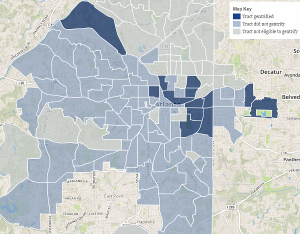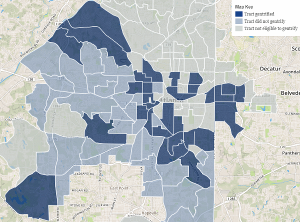February 2016 archive
His and Hers: Designing for a Post-Gender Society is an article published on Metropolis magazine which is written by Suzanne Tick in March of 2015. She is the creative director for Teknion Textiles and also the United States’ number one leading textiles designer. In this article she argues for gender neutrality in the workplace.
The article opens up talking about how society’s roles of traditional females and males are changing. This is mostly due to the advancements of science and technology. She begans to address how designers should be on the lookout for advancement too, in order to accommodate these cultural changes in order to promote acceptance as society has.
We address how feminism is now making its way into this once male dominant society. For many years males have always been dominated in power, certain job fields and in top offices, with the example being that eighty-five percent of IT and web design being male.
Emma Watson’s “He for She” movement speech has went viral causing a lot of support for gender equality. Currently, gender roles have been altered in the workplace as women become more important. With all of this taking place, the actual designs of places have become a lot softer creating a gender neutral working environment with open windows, carpet and textiles.
She talks about how gender roles have been switched and that fashion and beauty were the first to embrace this change by some making products like makeup more appealing for men, and women’s coats getting a masculine, militia cut. She then goes on to discuss the confusion of gender roles in today’s society. Which I believe was inevitable. Nothing is solely for women or for men these days. Especially given the fact that now we have children who oppose to being identified by either male or female at school, but rather just an individual.
We also discuss the recent changes in corporations in adopting gender-neutral atmospheres such us workplaces and not to mention bathrooms, which seems to be a great deal debate. The idea is to grow with society’s advancements allowing everyone to feel a sense of inclusion and acceptance all while feeling comfortable in their work environments or in any places open to the public.
She then speaks about how girls are dressed like boys and boys dressed like girls and how adrogony is truly taking place in today’s society. People have the opportunity to be whatever and play whatever roles they want to these days and how schools and fashion designers have become accepting of these things in ways of creating multistall restrooms and creating clothing designs that fits individuals and not just females or males.
Tick then discusses the trans CEO of United Therapeutics, who is the highest paid female executive in the United States, who was biologically born male. This goes to show how things has made a tremendous turn around and this is only the beginning.As we made advancements in our society,we must stay alert and ahead with our design to help implement change.
Making Bathrooms More Accommodating, is an article written by Emily Bazelon. This article was published by The New York Times Magazine in November 2015. With all the new changes in our society, given the LGBT community, the openness of transgender people and the transitioning phase, this article seems to have come right on time.
In the article. Bazelon talks about the up in the air discussion about the gender specific bathroom and shower/locker room laws which arises the three questions that transgenders would want to be addressed. Those questions range from the topic of signage(what do we about it/ do we get rid of female/male restrooms, architectural design-creating multistalls of said bathrooms and most importantly who gets access where (should a person who identifies as male enter into a female restroom or vice versa).
Going to the restroom in public is something that we all find ourselves having to do, but one thing we all have in common is the sense of feeling comfortable when entering into a bathroom and shower/locker room. Which is why this article brings up an important discussion as to how we plan on accommodating transgender people, whether we want to or not. See one thing about this is, as society changes, we tend to want to make everyone feel comfortable, welcomed and most importantly equal, but as we create new laws to form equality, there are other things that must be in line for that to take place. For example: we establish that any said transgender person should be acknowledged as the preferred gender of their choice, but if we acknowledge a male as a female, why would it not be okay for them to enter into a restroom designed for females and of course the same would be considered for a female wanting to be addressed as a male.
This article talks about the concerns of both transgenders and also those who oppose the “Bathroom Ordinance. In Houston, Texas those who opposed this law created television ads and shirts of harassment of women by males in restrooms, which is something that many of those opposers would be afraid of and a good reason for the unwillingness to conform to this new law of accommodation.
In this article, Bazelon speaks about a twelve year old male transitioning into a female, and how she requested to change alongside her peers in the locker room and the denial of that request, which led to a civil rights lawsuit that then resulted in “her” being able to change alongside her peers with a privacy curtain that even others can take privacy in as well.
The article then goes on to discuss how female and male bathroom separation came into existence and the comparison to the “water closets in the Victorian Era” that separated men and women. We talk about women and their desire for female privacy, and camaraderie that we break into when we head to the bathrooms for chatty talk time with other females and why it would be a disturbance to welcome male anatomy into our place of privacy and protection while we relieve ourselves and socialize in peace.
The article then begins to discuss the oversimplification of transgenders and their biological chromosomal makeup. Here we discuss their desires for inclusion the same way we provide ways for those with disabilities and what would help them feel just as included.
In this article it gave me great insight of how they may feel, especially in the ending of the article where it discusses the twelve year old who states she feels a sense of normality when she’s around other girls in the locker rooms, instead of feeling overexcited as if she is anything different. What sums it up to me is that it’s not them that feel uncomfortable in their bodies but it is us.
The article wraps up by giving two possible accommodations: invisibility-not looking at or speaking to anyone and gender proof- showing physical characteristics that show that you belong there. (pretty genius)

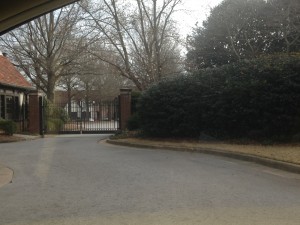
This is the entrance to the East Lake Golf Club which sits back away from the road. This entrance is gated and only allows members access. Through research I found out that membership is by invitation only through corporations, and there is no individual memberships available. The entrance is very subtle and private, leaving no mistakes to wander in.

As I wandered alongside the gates, I found two Caucasian older gentlemen playing golf. The course is very private so me hanging around probably arouse suspicion. Walking around I did not feel as if I belonged. The guys, on the other hand seem to be enjoying themselves in this windy, chill relaxed environment.
IMG_2456
Here is just a brief video clip of the golf course and the scenery it provides. In this clip, there is no sound. The only thing you can here is the wind rustling in the camera’s speaker piece. It was very quiet out which contributes to a very peaceful environment tucked away from the rest of the neighborhood. The only thing to listen to is the birds soaring across the sky and the squirrels ruffling in the trees above.
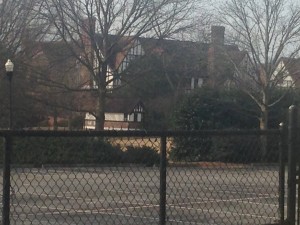
In this picture you can see the Golf Club house sitting upon a hill towards the back. It kind of gives a country feel with the trees blocking the view. The colors also contributes to the country atmosphere with the brown, forest green bushes and bare trees in the distance. It definitely is the highlight of the East Lake neighborhood.
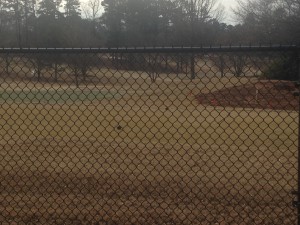

In these last photos, and every photo previously you can see how excluded the Golf Course is from the rest of the neighborhood. Fences surround the entire course. The area surrounding this is very closed in and private, the fences seem to provide more purpose than keeping the golfers balls from wandering outside the perimeters but it ensure no loitering or mistaken wandering access. The grass is very well kept, trimmed to perfection.
Description of East Lake Neighborhood (Golf Course)
As I observed the Golf course and its surroundings. I could really understand how it would be the highlight of the neighborhood. It is the oldest golf course of Atlanta, established in the beginning of 1904. It is in the East part of downtown Atlanta in East Lake neighborhood. It is a very well kept club house surrounded by nicely remodeled houses. Although the grass is not the greenest at this time of year, it creates a country feel with crisp cold breeze in the air with the smell of fresh cut grass.
The golf course sits away from the road with a gated entrance way leading to the club house that sits at the top of a hill being seen from the road but unfortunately not accessible unless you have a membership, which is by invitation only. It seems to only be useful to the elite class of people being that there only seemed to be older white guys playing golf on a Sunday afternoon.
From the look of the neighborhood, this golf course is not intended for regular individuals as myself, so walking around viewing the scenery made me feel out of place even though I was not in a place of danger. I received awkward stares that made me want to hurry and leave, but that’s when I realized that this is what I was here for: to find the exclusions where we think there are none.
As I got ready to leave the course, I realized how once I left the vicinity of the golf course, there were several black children and adults with their children at the nearby park that wasn’t as well kept. Although they seem to be having quite some fun. The park wasn’t the worst but it seemed to be in different world than the golf club, though it was barley around the corner. The benches were rusted with paint wearing away, and knocked over trash cans and such. The environment took a complete turn that I did not expect.


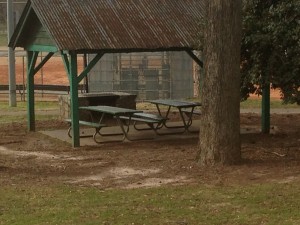
Annotated Bibliography 1:
“An Atlanta Neighborhood Tries To Redefine Gentrification.”Frontiers of Race, Culture and Ethnicity. Code Switch, 23 Sep 2015. Web. 04 Feb 2016. <http://www.npr.org/sections/codeswitch/2015/09/23/435293852/an-atlanta-neighborhood-tries-to-redefine-gentrification>.
This article discusses how the east lake golf club that sits in a neighborhood that once was in the middle full of crime, poverty and public housing projects ,and a Golf course with dry patchy land where golfers risked the case of a stray bullet, but is now a PGA tour stop due to the redevelopment and Golf Club. The neighborhood was so full of trouble and crime that it was known as the war zone and nick named “Little Vietnam”. It discusses how the crime rate was 18 times the national average. The article talks about how the golf club helped reestablish the community by being a source of funds and support. Although the intentions of the reconstruction was to create mixed-income housing to go along with schools, child care and jobs of quality article discusses how the some people were forced out of the new found transformed neighborhood due to certain requirements.
I think this article is important because it gives insight from the residents who once belonged to that community before the gentrification. This article provides so much history on what East Lake neighborhoods were like and how deprived and forsaken they were. It provides information on how the changes began and the effects of those changes. Whether good or bad, it gave testimonies on how it affected those looking for a stable safe place to live and raise families and also those who were forced to remove themselves due to those new requirements.
Annotated Bibliography 2:
Deirdre A. Oakley. “ASA Footnotes: A Publication of American Sociological Association.” Annual Meeting Premieres The Atlanta Way: A Documentary on Gentrification. ASA, Jul 2010. Web. 2 Feb 2016. <http://www.asanet.org/footnotes/julyaugust10/am_0710.html>.
This article is a profound one.it talks about the first premiere of the documentary. It also discusses the contradictory effects of the gentrification of the Atlanta neighborhoods that has been taken place and causing the predominantly poor black neighborhoods more suitable for affluent white people who can afford the upgraded living areas. It had great details about the purpose of the film with several interviews including Professor Deirdre A. Oakley. She expressed her opinion with great knowledge of what has been taking place in Atlanta residence. She summarizes her views of how this is creating a less diverse environment and how one sided the benefits are for those who can afford to remain or move to Atlanta.
She gives details and information about the writer of the film, King Williams in an interview segment that wouldn’t likely be found anywhere else.it allowed him to tell his story and give us a view of what was in his mind when he created the film and what inspired him to do so.
This article is a great resource for capturing the highlights of the film and to get insight on what gentrification is and how homelessness and displacement occurred in our city. Through this site, there lies more information about gentrification and how it’s like a two sided coin and were only looking at the side that is turned up our way.
Annotated Bibliography 3:
Max Blau. “Creative Loafing.” Can Anyone Stop Atlanta’s Gentrification. 13 Feb 2015. Web. 04 Feb 2016. http://clatl.com/freshloaf/archives/2015/02/03/can-anyone-stop-atlantas-rapid-gentrification.
Can Anyone Stop Atlanta’s Gentrification is a detailed article that has maps describing and illustrating the gentrification process since the 1990s and now the most recent map of 2015. The maps are vivid, well researched and informative.
The article provides a lot of documentation on what has been happening nationally to gentrify our cities. The author states that gentrification is happening but it is also causing our neighborhoods to become more affluent driving out the previous residents that were predominantly black. The article begs the question of what is actually happening to those who previously resided in these project homes now turned lofts and condos. This also leaves us to the bigger question, is this really a good thing and if possible is there any way to stop the gentrification. This article has statements from Mayor Kasim Reed and other government officials and their views of the rapid gentrification.
This source provides helpful information on the gentrification and illustrations showing how Atlanta is gentrifying twice as fast than any other city in America. It also discusses census data for 50 of the nation’s largest cities, which was published by Governing This Month.
